 |
 |
|||||||
|
|
||||||||
| Bando-Aspekte Bandoneon aspects aspectos aspects aspetti Modellübersicht list of classic models lista de modelos clásicos liste des modèles class. elenco di modelli classici Originalstempel original labels & marks sellos originales marques original marchi originali Stempel labels, stamps & marks sellos y etiquetas etiquettes et marques etichette e marchi Hersteller list of producers fabricantes producteurs produttori Historisches historical histórico historique storico Foto & Literatur photo & literature foto & literatura photo & littérature foto & letteratura |
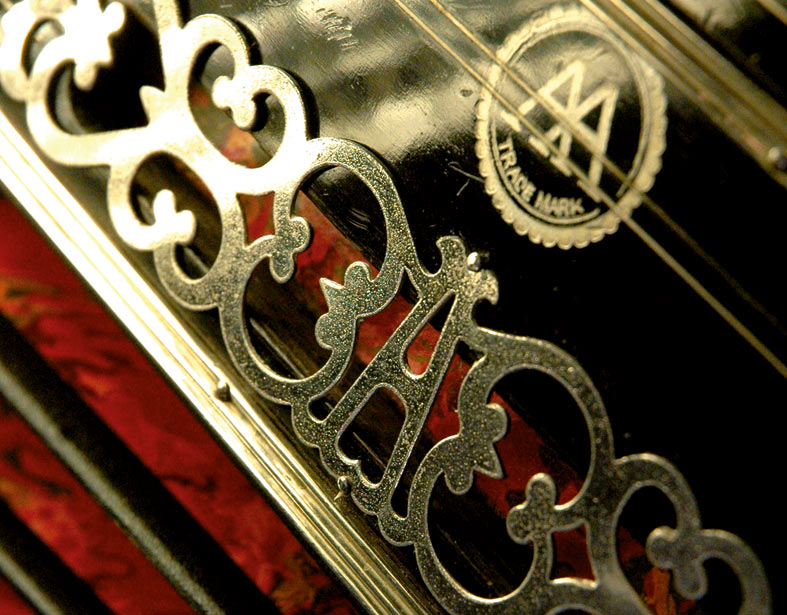 |
|
| Modellübersicht der verschiedenen Hersteller des Exportmodells (142-wechseltönig, Rheinisch, "Tango") |
list of classic models of the different producers of the export model (142-diatonic) lista de modelos clásicos de los diferentes fabricantes del modelo de exportación (142-diatonico) liste des modèles classiques des différents fabricants du modèle d'exportation (142-diatonique) elenco di modelli classici dei diversi produttori del modello di esportazione (142-diatonico) |
| AA / Alfed Arnold | |
 Klassische Aussägearbeit an einem Alfred Arnold Bandoneon. Diese Gestaltung im Deckel der rechten Hand wurde bis kurz vor Ende der Produktion des Vorkri.-Modelles genutzt. Auch mit Einführung der neuen Gestaltung der Aussägearbeit mit zwei stilisierten A, vermutlich ab 1932 (siehe unten), wurde das klassische Design parallel beibehalten. Classic design on an Alfred Arnold Bandoneon. This design in the lid of the right hand was used until shortly before the end of the pre-wr. production. Even with the introduction of the new design of the sawing work with two stylized A, probably from 1932 (see below), the classic design was maintained in parallel. |
|
 |
... siehe auch "Hersteller" ... see also "list of producers" ... siehe auch "Statistiken" ... see also "statistics" |
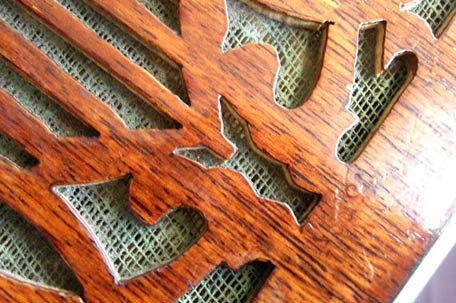 Die klassische Aussägearbeit an einem AA unterscheidet sich stets in einem Detail. In der Mitte, unterhalb der stilisierten Lyra, ist es oft gar nicht ausgesägt, in der Form eines Hasen ausgesägt (wie hier) oder in Form eines Fuchses (siehe rechtes Bild). The classic design on an AA always differs in one detail. In the middle, below the stylized lyre, it is often not sawn at all, sawed out in the shape of a rabbit (as here) or in the form of a fox (see right picture). |
 Hier die klassische Aussägearbeit an einem AA mit geprägter, sechsstelliger Nummer. Instrumente mit der anderen Aussägearbeit, der mit den zwei stilisierten A (siehe unten), trägt eine solche Nummer (als Exportmodell) immer. Bei diesem klassischen Design ist sie selten. Here the classic design on an AA with an embossed, six-digit number. Instruments with the other sawing work, the one with the two stylized A (see below), always shows such a number. It is rare in this classic design. |
 Klassisches AA mit zwei stilisierten A neben einer dreisaitigen Lyra. Diese Aussägearbeit im Deckel der rechten Hand findet man ab ca. 1932 parallel zu der klassischen mit Ranken neben einer fünfsaitigen Lyra (siehe oben). Das ausgesägte A vor dem Griff ist bei beiden Gestaltungen gleich. Classic AA with two stylized A next to a three-string lyre. This sawing work in the lid of the right hand can be found from around 1932 parallel to the classic one with tendrils next to a five-string lyre (see above). The sawn-out A in front of the handle is the same for both designs. |
|
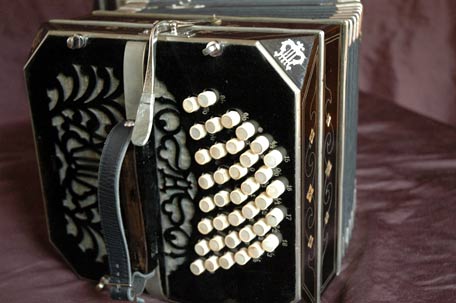 Das stilisierte "A", ausgesägt im Deckel zwischen Tastatur und Griff, ist typisch für Instrumente von Alfred Arnold. The stylized "A", sawn out in the lid between the keyboard and handle, is typical of Alfred Arnold instruments. |
 |
 PREMIER ist ein Modell von Alfred Arnold. Das Wort "Premier" ist immer statt dem sonst üblichen "A" vor beiden beiden Griffen ausgesägt PREMIER is a model of Alfred Arnold. The word "Premier" is always cut out between keyboard and handle on both sides instead of the usual "A" |
|
 |
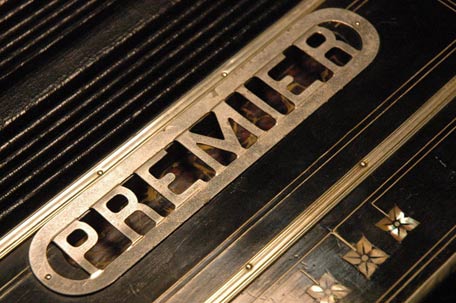 |
 |
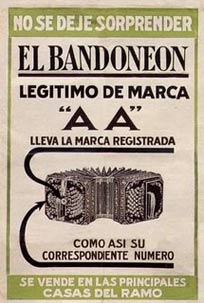 ... siehe auch "Originalstempel" ... siehe auch "Originalstempel"... see also "original labels & marks" |
 Das für Alfred Arnold typische "A" oder Schriftzug "Premier", stilisiert in der Aussägearbeiten in den Deckeln vor den Griffen, ist bei seltenen Instrumenten anders gestaltet. Es ist eine Raute über einem Bogen ausgesägt. Die Gestaltung der Deckel der sonst baugleichen AA-Instrumente wurde für die Importeure "Palacio de le Musica" (Campo) in Montevideo / Uruguay und "Casa America" in Buenos Aires so produziert. The typical Alfred Arnold "A" or lettering "Premier", stylized in the sawing out of the lids in front of the handles, is designed differently on rare instruments. It is a rhombus sawn out over an arch. The design of the lids of the otherwise identical AA instruments was produced in this way for the importers "Palacio de le Musica" (Campo) in Montevideo / Uruguay and "Casa America" in Buenos Aires. |
 "Campo" Fabricado especialmente para Palacio de la Musica por Alfred Arnold-Carlsfeld ("Campo" fabriziert speziell für Palacio de la Musica von Alfred Arnold-Carlsfeld-Deutschland). "Campo" Fabricado especialmente para Palacio de la Musica por Alfred Arnold-Carlsfeld ("Campo" fabricated specially for Palacio de la Musica by Alfred Arnold-Carlsfeld-Germany). |
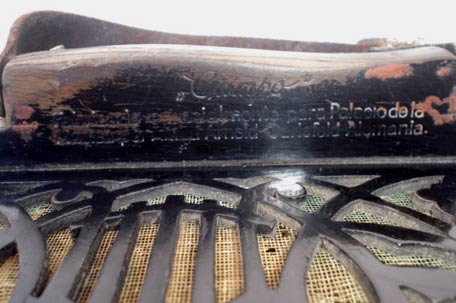 "Campo" Fabricado especialmente para Palacio de la Musica por Alfred Arnold-Carlsfeld ("Campo" fabriziert speziell für Palacio de la Musica von Alfred Arnold-Carlsfeld). "Campo" Fabricado especialmente para Palacio de la Musica por Alfred Arnold-Carlsfeld ("Campo" fabricated specially for Palacio de la Musica by Alfred Arnold-Carlsfeld) |
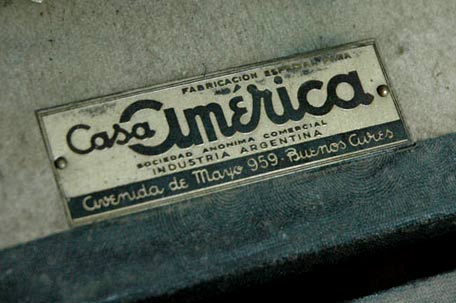 Casa América, Av. de Mayo 959, Buenos Aires / Argentina |
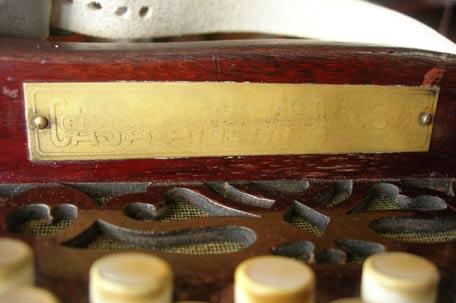 Die Raute mit Bogen (statt "A") in den Aussägearbeiten in den Deckeln zwischen Griff und Tastatur habe ich auch bei AA- Instrumenten gesehen, die von "Casa America" in Buenos Aires / Argentinien importiert wurden. Auch hier fehlt eine Dokumentation oder eine verläßliche Quelle. Man kann leider nur anhand von Indizien vermuten. I also saw the rhomb with bow (instead of "A") in the sawing work in the covers of Alfred Arnold instruments imported from "Casa America" in Buenos Aires, Argentina. Documentation or a reliable source is also missing here. Unfortunately, one can only guess on the basis of evidence. |
 Casa América, Av. de Mayo 959, Buenos Aires / Argentina ... siehe auch "Originalstempel" ... see also "original labels & marks" ... siehe auch "Statistiken" ... see also "statistics" |
 AA Trade Mark. Prägestempel in einem Diskantgriff AA Trade Mark. Embossed stamp in a right hand handle ... siehe auch "Originalstempel" ... see also "original labels & marks" |
 Ein Sondermodell ist das sogenannte "Luis XV". Diese Bezeichnung bezieht sich auf den Möbelstil der hier in den geschweift geschwungenen Gehäuse zu sehen ist. Diese Gehäuseform gibt es von AA sowie von ELA. Sie sind von beiden Herstellern fast immer mit den für die damalige Zeit in Deutschland hochwertigeren Aluminiumplatten produziert worden. A special model is the so-called "Luis XV". This designation refers to the furniture style that can be seen here in the curved housing. This type of housing is available from AA and from ELA. Both manufacturers almost always produced them with aluminum plates what was in Germany the highest layout at that time. |
| ... siehe auch "Hersteller" ... see also "list of producers" ... siehe auch "Statistiken" ... see also "statistics" |
 |
| ELA / Ernst L. Arnold | |
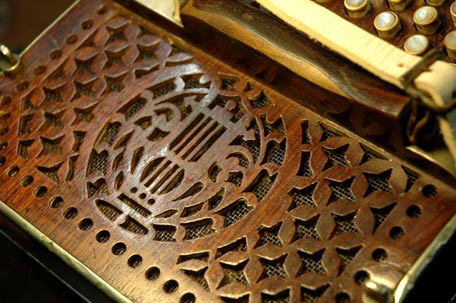 ELA-Bandoneon mit der typischen Aussägearbeit mit stilisierter Lyra umrandet von floralem Muster im Kreis umgeben von 4-zackigen Sternen. Nur die hier sichtbaren Lochbohrungen um die Aussägearbeit ist nicht immer komplett oder fehlt auch. Ansonsten hatte ELA immer diese typische Gestaltung. ELA Bandoneon with the typical sawing work with stylized lyre surrounded by a floral pattern in a circle surrounded by 4-pointed stars. Only the holes around the sawing work that are visible here are not always complete or are also missing. Otherwise, ELA always had this typical design. |
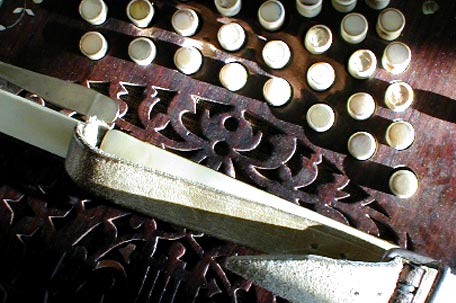 ELA-Bandoneons haben nur mit einer Ausnahme immer diese florale Gestaltung zwischen Griff und Tastatur. Die stilisierte Rose ist typisch. Die Ausnahme ist das ELA-Cardenal (siehe unten). With one exception, ELA Bandoneons always have this floral design between the handle and the keyboard. The stylized rose is typical. The exception is the ELA Cardenal (see below). |
 |
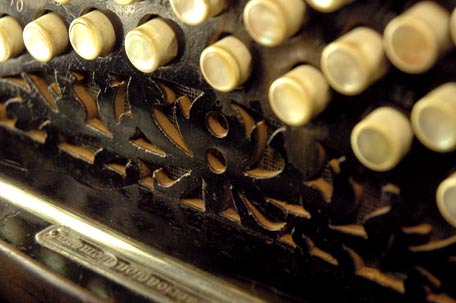 |
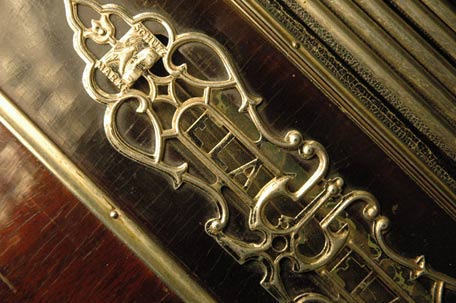 Luftklappenschild eines ELA-Bandoneons. Da die Kürzel "ELA" zweimal zu sehen sind, werde diese Modelle in Argentinien oft "ELA-ELA" genannt. Docorative plate of an ELA bandoneon. Since the abbreviation "ELA" can be seen twice, these models are often called "ELA-ELA" in Argentina. |
... siehe auch "Originalstempel" ... see also "original labels & marks" ... siehe auch "Statistiken" ... see also "statistics" |
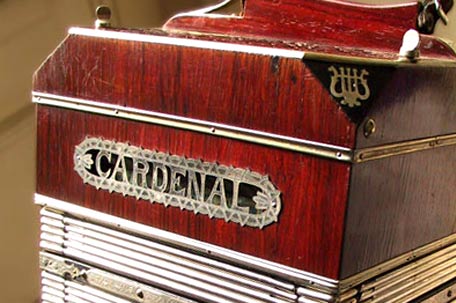 ELA versah seine Instrumente mit einer Reihe an verschiedenen Modellnamen. So gab es das Modell Cardenal, Germania, America, Echo, Tango und mehr. Im technischen Sinne haben sich die Modelle nicht grundlegend voneinander unterschieden. Der Unterschied bestand meist nur im schön gestalteten Metallschild über der Luftklappenöffnung. Die Ausnahme ist die Aussägearbeit beim Modell "Cardenal" zwischen Griff und Tastatur (siehe rechts). ELA provided its instruments with a number of different model names. So there were the models Cardenal, Germania, America, Echo, Tango and more. In the technical sense, the models did not differ fundamentally from one another. The difference was mostly only in the beautifully designed metal plate above the air flap opening. The exception is the sawing work on the "Cardenal" model between the handle and the keyboard (see right). |
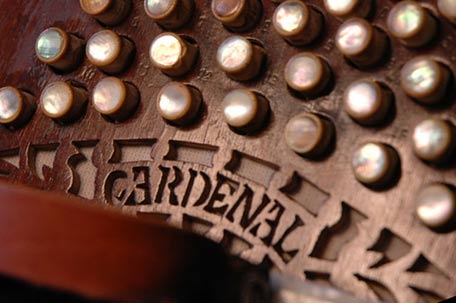 Die für ELA sonst typische Rose als Aussägearbeit zwischen Griff und Tastatur ist hier die Modellbezeichnung Cardenal. The typical rose for ELA as work between the handle and keyboard is here the model name Cardenal. |
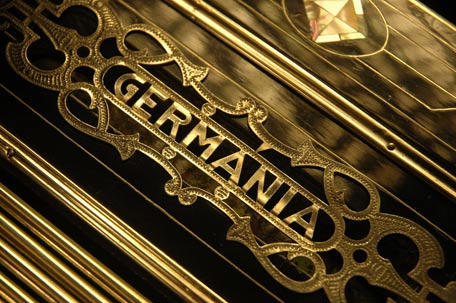 Im Jahre 1906 entwickelte Alfred Wilm (1869-1937), ein Deutscher Metallurge, das im Vergleich zum natürlichen Aluminium härtere Duralumium (auch Dural genannt). Das neue, vergleichsweise leichte Material, eröffnete ein neues Zeitalter. Besonders der Flugzeugbau profitierte. Das moderne Material wurde besonders von ELA für die Stimmplattenherstellung genutzt. Ein Instrument mit Aluminiumplatten kostete einen Aufpreis, wie wir noch in Katalogen sehen können. In Argentinien blieb das Zink als Plattenmaterial beliebter. Ein Bandoneon mit Zinkplatten ist allein durch das höheres Gewicht leichter laut zu spielen, was im Tango und besonders zu der damaligen Zeit beliebt war. Statistisches Verhältnis der vor dem Krie. gebauten Exportbandoneons mit 142 Tönen (nach eigenen Daten): ELA: 64,5% Alumium / 35,5% Zink (100% = 230 Instrumente) AA: 4,5% Alumium / 95,5% Zink (100% = 580 Instrumente) Viele der seltenen Zinkplatteninstrumente von ELA sind das Modell "Germania". |
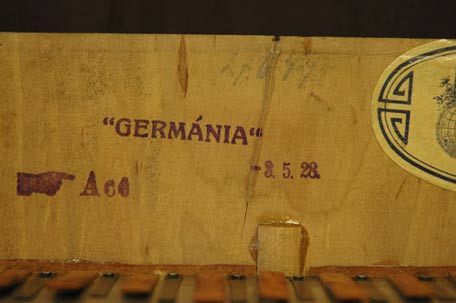 In 1906 Alfred Wilm (1869-1937), a German metallurgist, developed the harder duralumium (also called Dural) compared to natural aluminum. The new, comparatively light material opened a new era. Aircraft construction in particular benefited. The modern material was used especially by ELA for the production of reed plates. An instrument with aluminum plates cost an extra charge, as we can see in catalogs. In Argentina, zinc remained more popular as material for the reed plates. A Bandoneon with zinc plates is easier to play loudly due to the higher weight alone, which was popular in Tango and especially at the time. Statistical ratio of the pre-wr. export bandoneons with 142 tones (according to own data): ELA: 64.5% aluminum / 35.5% zinc (100% = 230 instruments) AA: 4.5% aluminum / 95.5% zinc (100% = 580 instruments) Many of the rare zinc plate instruments from ELA are the "Germania" model. |
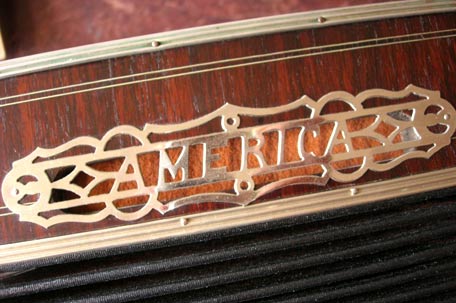 |
 |
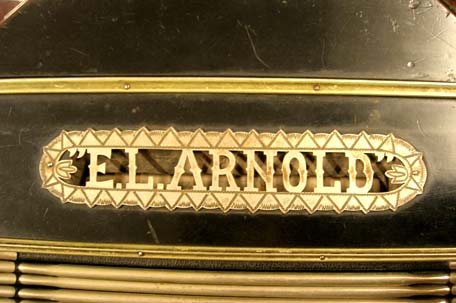 |
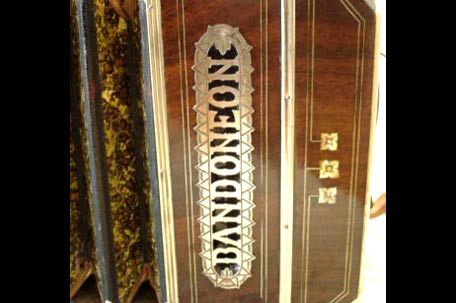 |
 |
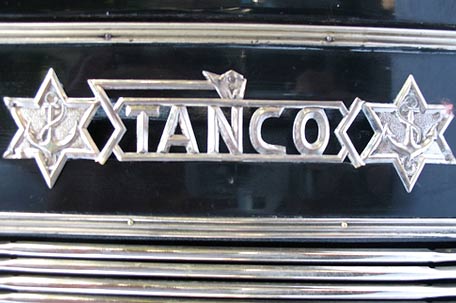 |
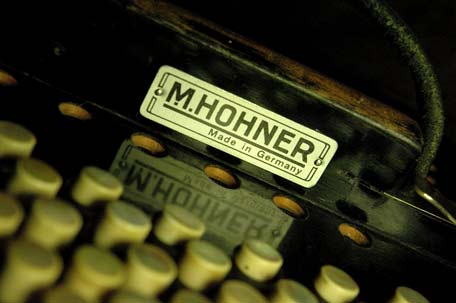 Die Modelle "Echo" und "Tango" wurden für Hohner hergestellt, - oder besser gesagt, ELA-Instrumente die durch Hohner exportiert wurden, bekamen ein solches Luftklappenschild und ein eigenes Schild. Hohner selbst hat keine Bandoneons hergestellt. The "Echo" and "Tango" models were made for Hohner, or rather, ELA instruments that were exported by Hohner were given such an air damper shield and their own shield. Hohner did not make Bandoneons himself. |
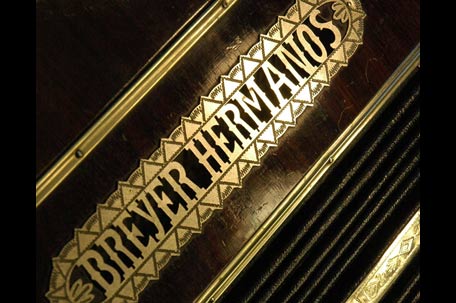 "Breyer Hermanos", ein Importeur in Buenos Aires, markierte die von ihm importierten Instrumente. Hier ein ELA aus den 20er-Jahren. Breyer Hermanos, Florida 414, Buenos Aires / Argentina Breyer, an importer in Buenos Aires, marked the instruments he imported. Here is an ELA from the 1920s. ... siehe auch "Originalstempel" ... see also "original labels & marks" |
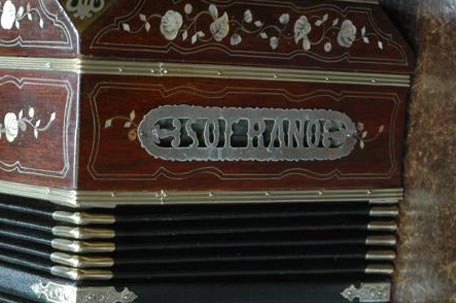 ELA Soprano |
 ELA Eolica |
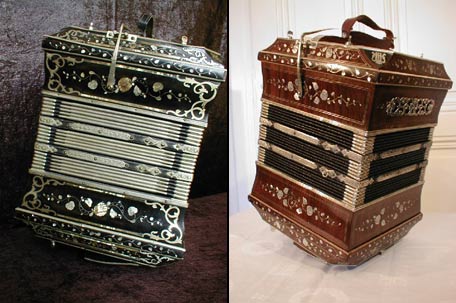 Ein Sondermodell ist das sog. "Luis XV". Diese Bezeichnung bezieht sich auf den Möbelstil der hier in den geschweift geschwungenen Gehäuse zu sehen ist. Diese Gehäuseform gibt es von AA sowie von ELA. Sie sind von beiden Herstellern fast immer mit den für die damalige Zeit in Deutschland hochwertigeren Aluminiumplatten produziert worden. A special model is the so-called "Luis XV". This designation refers to the furniture style that can be seen here in the curved housing. This type of housing is available from AA and from ELA. Both manufacturers almost always produced them with aluminum plates what was in Germany the highest layout at that time. |
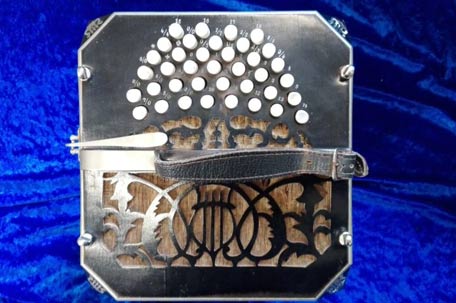 Kurz vor Ende der Vorkr.-produktion, gegen 1939, änderte ELA die typische Gestaltung der Aussägearbeiten in den Deckeln. Auch die Kanzellenformen haben sich äußerlich minimal verändert. Diese seltenen Modelle von 1939 und 1940 kenne ich nur mit Zinkplatten. Shortly before the end of pre w. production, ELA changed the typical design of the sawing work in the lids. The shape of the reed chambers has also changed minimally on the outside. I only know these rare models from 1939 and 1940 with zinc reed plates. |
| Arno Arnold | |
 Arno Arnold war der Neffe von Alfred Arnold und alleiniger Geschäftsführer der Firma Alfred Arnold ab 1933. Mit dem Entstehen der Bundesrepublik ging Arno Arnold 1949 nach Obertshausen bei Frankfurt am Main. Bis 1971 produzierte die Firma noch Bandoneons. Heute ist Arnold ein Produzent von Schutzabdeckungen. Bereits 1930 erteilte das Reichspatentamt Alfred Arnold in Carlsfeld das Patent "Harmonikaförmig gestalteter Balg zur Schutzabdeckung für Führungsbahnen an Werkzeugmaschinen ..." ... mehr: www.arno-arnold.de |
 Arno Arnold was the nephew of Alfred Arnold and sole managing director of the Alfred Arnold company from 1933. With the emergence of the Federal Republic in 1949 Arno Arnold went to Obertshausen near Frankfurt am Main. The company still produced bandoneons until 1971. Today Arnold is a producer of protective covers. Already in 1930 the Reich Patent Office Alfred Arnold in Carlsfeld granted the patent "Bellows designed in the form of an accordion to protect guideways on machine tools ..." ... see more: www.arno-arnold.de |
| Trés B / Meinel & Herold | |
 Meinel & Herold hat nur wenige Instrumente im Vergleich zu AA und ELA nach Südamerika exportiert. Sie sind rar. Meinel & Herold has only exported a few instruments to South America compared to AA and ELA. They are rare. |
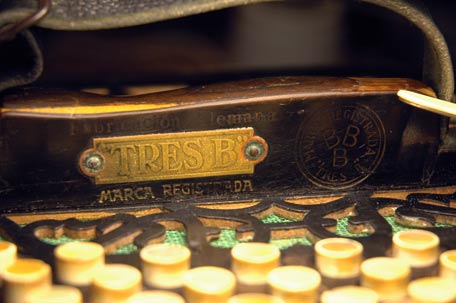 Die Exportmarke "BBB" oder auch "Trés B" sind sehr schöne Instrumente von Meinel & Herold für den damaligen Export. The export brand "BBB" or "Trés B" are very nice instruments from Meinel & Herold for the export at that time. |
 |
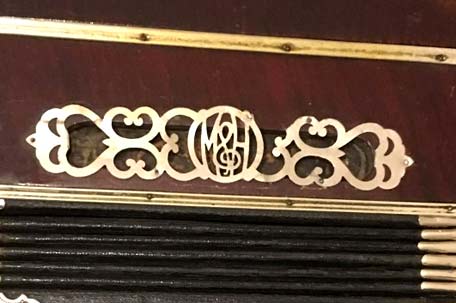 |
 Sehr seltenes Modell mit der Bezeichnung "G. Zimmermann". Ob sich Meinel & Herold auf "Carl & W. Zimmermann" beziehen, die Vorläufer der ELA-Fabrik, ist unklar. Very rare model with the designation "G. Zimmermann". If Meinel & Herold refers on "Carl & W. Zimmermann", the precursor of the ELA factory, is unclear. |
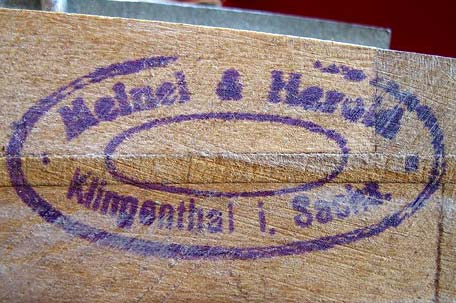 Meinel & Herold, Klingenthal in Sachsen. Stempel an der Kopfseite einer Baßkanzelle ... siehe auch "Originalstempel" Meinel & Herold, Klingenthal in Sachsen. Stamp at the head side of a bass chamber ... see also "original labels & marks" |
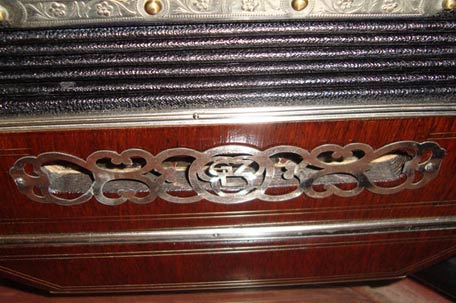 "G. Zimmermann" von Meinel & Herold. |
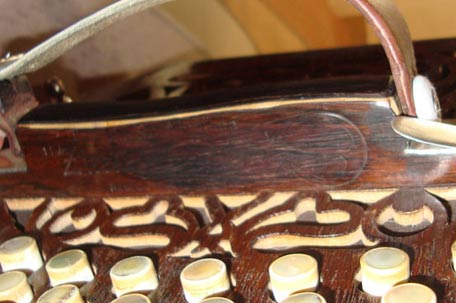 "G. Zimmermann" von Meinel & Herold. |
| Verschiedene Hersteller | various producers |
 Ein ausgesägtes "M" an einem "Gebrüder Meinel" ... zum Instrument A cut out "M" at an "Gebrüder Meinel" ... see the instrument |
 Ein ausgesägtes "M" an einem "Mariani" / Buenos Aires / Argentina ... siehe auch "Hersteller" A cut out "M" at an "Mariani" / Buenos Aires / Argentina ... see also "list of producers" |
| Kurioses | oddities |
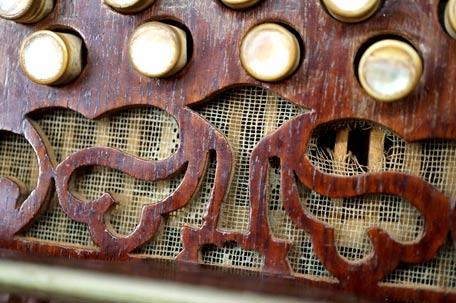 Seltsam ausgesägtes "A" an einem Alfred Arnold ... zum Instrument Strange cut out of an "A" at an Alfred Arnold ... see the instrument |
| Dekore |
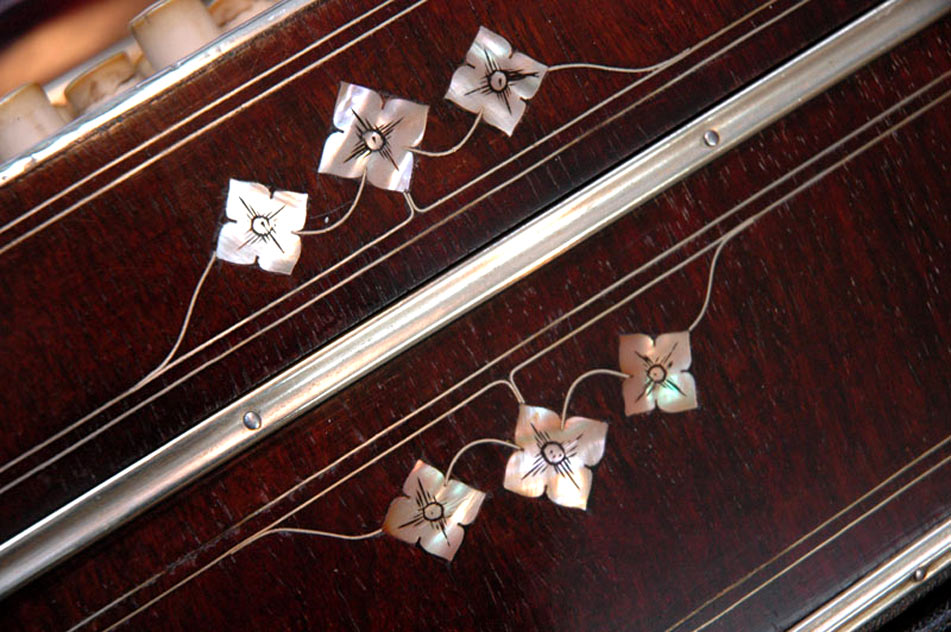 Seltenes Dekor in einem ELA von 1927 ... Instrument - rare decor in an ELA from 1927 |
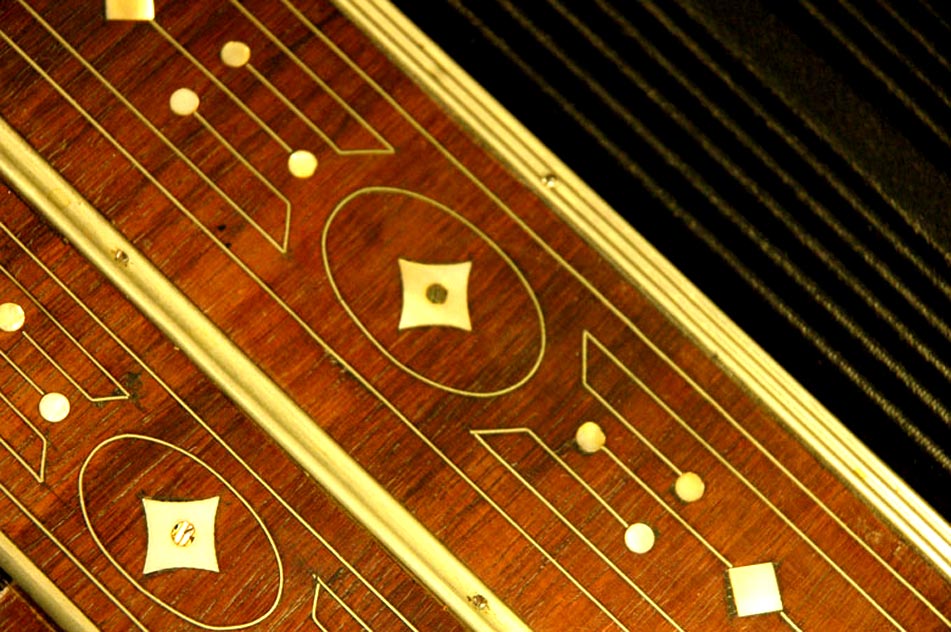 Seltenes Dekor in einem Meinel & Herold ... Instrument - rare decor in an Meinel & Herold |
| Lyren | Lyres |
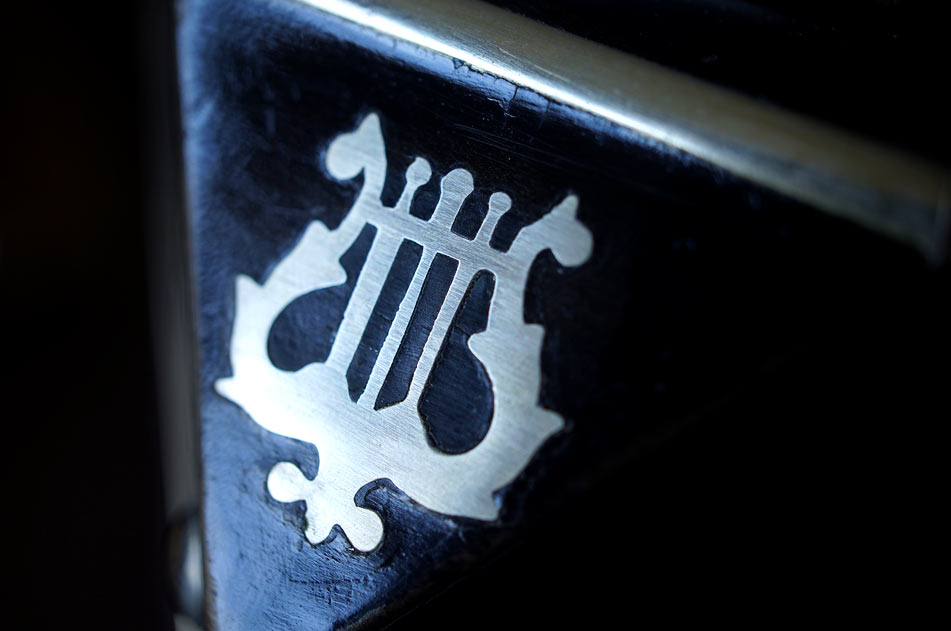 AA / klassische Form ... Instrument AA / classic form ... instrument |
|
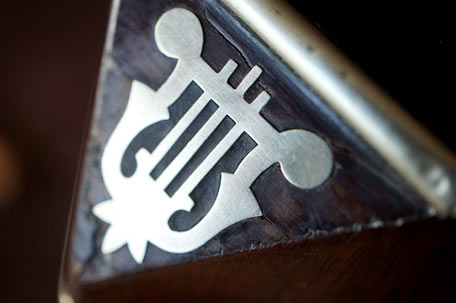 AA / klassische Form ... Instrument AA / classic form ... instrument |
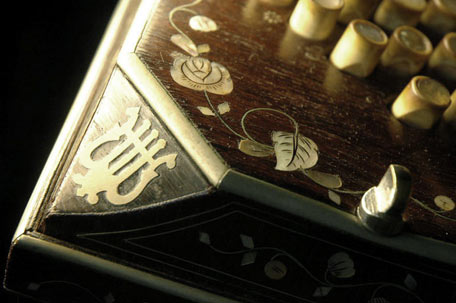 Geschwungene Lyra in einem AA / Louis XV ... Instrument Curved lyre in a AA / Louis XV ... instrument |
 Die Lyren sind hier noch nicht gestanzt sondern von Hand gesägt. Man erkennt an der oberen linken Seite den Eingang der Säge um das Innere in einem Gang sägen zu können. Die leichte Unperfektion der linken und rechten Seite, die eben nicht perfekt gespiegelt sind, macht die Erscheinung in meinen Augen so natürlich und schön. Sie ist "unperfekt" wie wir. Als Teil der Natur rührt uns das an ... Instrument The lyres here are not yet punched but sawed by hand. You can see on the upper left side the entrance of the saw to be able to saw the inside in one go. The slight imperfection of the left and right sides, which are just not perfectly mirrored, make the appearance so natural and beautiful in my eyes. It is "imperfect" like us. As part of nature, this touches us ... instrument |
|
 Von Hand ausgesägte Lyra an einem ELA ... Instrument Hand sawed lyra in an ELA ... instrument |
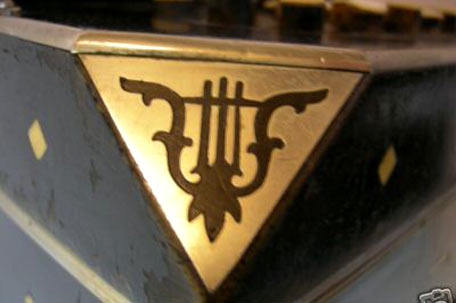 Hier wurde die verbleibende Materialplatte verwendet, nachdem die Lyra von Hand ausgesägt wurde (siehe Modell links) Here the remaining material plate was used after the lyre was sawn out by hand (see model on the left) |
| © 1998-2023 BANDO BANDO Wuppertal | |
| Kontakt / Impressum Datenschutzhinweis & Hinweise zur Nutzung |